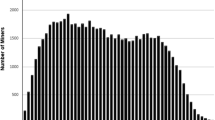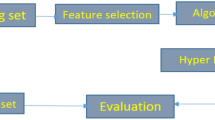Abstract
Despite technological advancements and organizational adjustments, lost time accidents are major issues in occupational safety. However, there is very limited work that focuses on variables influencing days lost as a result of occupational accidents. In this study, decision tree and artificial neural network methods were used as machine learning techniques to investigate the impact of factors on accident lost day duration. Degree of injury, worker age, and worker activity were found to be the top three variables impacting loss of time from work. It was also identified that the mining method, location, and nature of injury had a moderate influence on duration lost due to occupational accidents. However, worker experience and ore type did not have any significant impact on the duration, which is an unexpected result. These results confirmed that some accident factors that might have a large influence on the number of mine accidents can be less critical when it comes to accident lost day duration.




Similar content being viewed by others
References
ILO (2019) Safety and health at work. http://www.ilo.org/global/topics/safety-and-health-at-work/lang%2D%2Den/index.html. Accessed on 11/13/2019
Gowrisankaran G, He C, Lutz EA, Burgess JL (2015) Productivity, safety, and regulation in coal mining: evidence from disasters and fatalities. National Bureau of Economic Research, Cambridge
Dhillon BS (2009) Mining equipment safety: a review, analysis methods and improvement strategies. Int J Min Reclam Environ 23(3):168–179
Sganzerla C, Seixas C, Conti A (2016) Disruptive innovation in digital mining. Procedia Eng 138:64–71. https://doi.org/10.1016/j.proeng.2016.02.057
Grayson RL (2008) Improving mine safety technology and training in the U.S. Recommendations of the Mine Safety Technology and Training Commission. J Coal Sci Eng 14(3):425–431
Lööw J, Nygren M (2019) Initiatives for increased safety in the Swedish mining industry: studying 30 years of improved accident rates. Saf Sci 117(January):437–446
Dündar S, Bilim N, Bilim A (2018) Ülkemizdeki Maden Sektöründe Meydana Gelen Iş Kazası Ve Meslek Hastalıklarının Analizi. Bitlis Eren Üniversitesi Fen Bilimleri Dergisi 7(2):423–432
Sanmiquel L, Bascompta M, Rossell J, Anticoi H, Guash E (2018) Analysis of occupational accidents in underground and surface mining in Spain using data-mining techniques. Int J Environ Res Public Health 15(3):1–11
Hermanus MA (2007) Occupational health and safety in mining - status, new developments, and concerns. J South Afr Inst Min Metall 107(8):531–538
Bayraktar B, Uygucgil H, Konuk A (2018) Türkiye Madencilik Sektöründe İş Kazalarinin İstatistiksel Analizi. Bilimsel Madencilik Dergisi (Özel Sayı):85–90.
Nowrouzi-Kia B, Gohar B, Casole J, Chidu C, Dumond J, McDougall A, Nowrouzi-Kia B (2018) A systematic review of lost-time injuries in the global mining industry. Work 60(1):49–61
Sanmiquel L, Rossell JM, Vintró C (2015) Study of Spanish mining accidents using data mining techniques. Saf Sci 75:49–55
Karra VK (2005) Analysis of non-fatal and fatal injury rates for mine operator and contractor employees and the influence of work location. J Saf Res 36(5):413–421
Kecojevic V, Komljenovic D, Groves W, Radomsky M (2007) An analysis of equipment-related fatal accidents in U.S. mining operations: 1995-2005. Saf Sci 45(8):864–874
Nowrouzi B, Rojkova M, Casole J, Nowrouzi-Kia B (2017) A bibliometric review of the most cited literature related to mining injuries. Int J Min Reclam Environ 31(4):276–285
Mirzaei Aliabadi M, Aghaei H, Kalatpour O, Soltanian AR, Nikravesh A (2018) Analysis of human and organizational factors that influence mining accidents based on Bayesian network. Int J Occup Saf Ergon 1–8. https://doi.org/10.1080/10803548.2018.1455411
Kniesner TJ, Leeth JD (2004) Data mining mining data: MSHA enforcement efforts, underground coal mine safety, and new health policy implications. J Risk Uncertain 29(2):83–111
Dessureault SD, Sinuhaji A, Coleman P (2007) Data Mining Mine Safety Data. Mining Engineering 59(8):64–70
Bakhshandeh Amnieh H, Mozdianfard MR, Siamaki A (2010) Predicting of blasting vibrations in Sarcheshmeh copper mine by neural network. Saf Sci 48(3):319–325. https://doi.org/10.1016/j.ssci.2009.10.009
Bakhshandeh Amnieh H, Siamaki A, Soltani S (2012) Design of blasting pattern in proportion to the peak particle velocity (PPV): artificial neural networks approach. Saf Sci 50(9):1913–1916. https://doi.org/10.1016/j.ssci.2012.05.008
Zhang Y, Zhang Y, Liu B, Meng X (2019) Prediction of the Length of Service at the Onset of Coal Workers’ Pneumoconiosis Based on Neural Network. Archives of Environmental & Occupational Health 75(4):242–250. https://doi.org/10.1080/19338244.2019.1644278
Paltrinieri N, Comfort L, Reniers G (2019) Learning about risk: machine learning for risk assessment. Saf Sci 118:475–486
Nowrouzi-Kia B, Sharma B, Dignard C, Kerekes Z, Dumond J, Li A, Larivière M (2017) Systematic review: lost-time injuries in the US mining industry. Occup Med 67(6):442–447
Knights P, Scanlan B (2019) A study of mining fatalities and coal price variation. Int J Min Sci Technol 29(4):599–602
Stemn E, Hassall ME, Cliff D, Bofinger C (2019) Incident investigators’ perspectives of incident investigations conducted in the Ghanaian mining industry. Saf Sci 112:173–188
Rogers WP, Kahraman MM, Dessureault S (2019) Formal Assessment and Measurement of Data Utilization and Value for Mines. Mining, Metallurgy and Exploration 36(2):257–268. https://doi.org/10.1007/s42461-018-0044-4
Erkayaoglu M, Dessureault S (2019) Improving mine-to-mill by data warehousing and data mining. Int J Min Reclam Environ 33(6):409–424
Vallmuur K (2015) Machine learning approaches to analysing textual injury surveillance data: a systematic review. Accid Anal Prev 79:41–49
Author information
Authors and Affiliations
Corresponding author
Ethics declarations
Conflict of Interest
The authors declare no competing interests.
Additional information
Publisher’s Note
Springer Nature remains neutral with regard to jurisdictional claims in published maps and institutional affiliations.
Rights and permissions
About this article
Cite this article
Kahraman, M.M. Analysis of Mining Lost Time Incident Duration Influencing Factors Through Machine Learning. Mining, Metallurgy & Exploration 38, 1031–1039 (2021). https://doi.org/10.1007/s42461-021-00396-w
Received:
Accepted:
Published:
Issue Date:
DOI: https://doi.org/10.1007/s42461-021-00396-w




